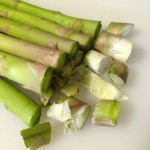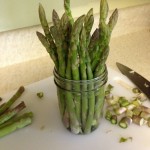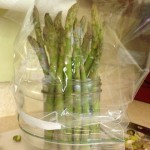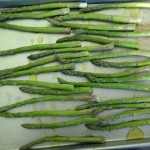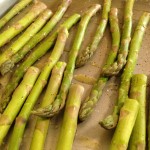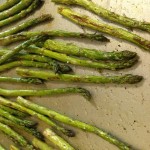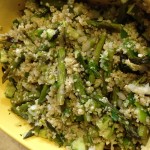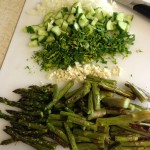This is the first in a series of Meatless Monday posts, based on Vermont Fresh: A Fruit and Vegetable Handbook. Our first post is about asparagus, one of the quickest and healthiest side dishes one can prepare.
Growing Tips
People start asparagus beds one of two ways: either they start the plants from seed or, more commonly, they plant “crowns,” segments of established asparagus roots. Plants started from seeds typically take about 3 years to produce good spears, so planting crowns is a good alter¬native for the impatient. Plant crowns in mid-spring in trenches about 6 inches deep. The closer you plant the crowns, the more slender your spears will be, but 10-12 inches is adequate space. Cover with 3 inches of soil initially, and then again in a few weeks. Asparagus grows well in rich, well-drained soil, meaning that you should apply compost regularly and plant in a location where water won’t puddle. Do not harvest spears the first year! When your asparagus has been growing for 2 or 3 years, harvest spears (either by snapping or by cutting close to the ground) that are about the thickness of your finger and 8-10 inches tall. Harvest for 4-6 weeks and then allow the remaining spears to develop into full-sized plants. The adult foliage nourishes the underlying crown; avoid cutting it back until it dies in the fall.
Nutritional Benefits
Asparagus is one of the best sources of folic acid, which lowers the risk of heart and liver disease as well as certain cancers. In addition to a wide variety of vitamins and minerals, asparagus also contains antioxidants and the phytochemical rutin. Rutin is believed to promote healthy blood vessels and capillaries. Asparagus is low in calories, too!
Preparation
Before cooking asparagus, remove the tough bottom ends by snapping them off where they naturally break. Some people choose to peel the skin off thicker spears as well. Asparagus can be simply boiled or steamed and served with butter. Cook until tender (5-10 minutes, depending on the size of the spears). Also great to eat raw.
Here’s a quick video on removing the tough bottom ends of asparagus:
Storage
Asparagus is best eaten right away, but it can be stored for a few days. Trim the bases of the asparagus stalks, set the bundle upright in a small bowl of water (like a bouquet), loosely set a plastic bag over the top, and store in the refrigerator.
- Photo by Judy Stermer
- Photo by Judy Stermer
- Photo by Judy Stermer
Recipe: Oven-Roasted Asparagus
Serves 4-6
Ingredients
- 1 or more bunches of asparagus
- 1-2 tablespoons olive oil
- Salt and pepper
- Lemon juice (optional)
- Butter
Instructions
- Preheat oven to 400 degrees.
- Trim tough lower ends off asparagus as indicated in “Preparation.”
- Spread the spears in a single layer on a slightly greased baking sheet.
- Drizzle olive oil over the asparagus and sprinkle lightly with salt and pepper.
- Bake until tender and browning at the tips, about 15 minutes.
- Drizzle very lightly with lemon juice.
- Serve warm with butter (optional).
Our own Director of Communications & Public Affairs, Judy Stermer, experimented with asparagus recipes this weekend. She says that 1 pound of asparagus (on sale now at Shaw’s) is $2.88per pound. 1 pound serves 4 as a healthy side.
- Photo by Judy Stermer
- Photo by Judy Stermer
- Photo by Judy Stermer
Judy created a new recipe for this Asparagus Meatless Monday.
Recipe: Quinoa Asparagus Salad
Serves 3, as main course. Serves 4 as side
Recipe total cost: $6
Ingredients:
- 1 cup uncooked quinoa
- 1 roasted asparagus recipe
- ½ onion, diced
- ¼ cup parsley, finely chopped
- 1 small cucumber, diced
- 2 cloves garlic
- Juice of one lemon
- Salt and pepper to taste
Instructions:
- Add quinoa and 2 cups water to sauce pan.
- Bring to a boil.
- Turn stove to medium low heat and simmer for 20mins or until quinoa has absorbed all the water
- While quinoa is cooking, prep all the veggies. You can add any veggies you have in your fridge or garden. Get creative!
- Once quinoa is done cooking, add all veggies, lemon juice and salt/pepper to taste. Serve warm or chill and eat later.
While quinoa is actually a seed, it cooks up much like a grain. It has a nutty flavor but takes on the flavor of any spice or broth added during cooking. Quinoa makes a great main dish as it is the ONLY plant based source of complete protein. “Complete” means that it contains all 9 of the essential amino acids that are crucial to human function and health. You can find quinoa in the bulk section of any coop or health food store. You can find it in a box in the health food section of Hannaford, Shaw’s and Price Chopper.
- Photo by Judy Stermer
- Photo by Judy Stermer
To receive more recipes and tips on your favorite fruits and vegetables, download Vermont Fresh: A Fruit and Vegetable Handbook.
We’re looking for more volunteers to test recipes and give us feedback on preparation time, cost and, of course, taste!

